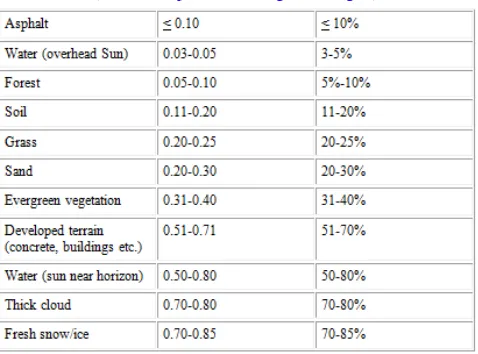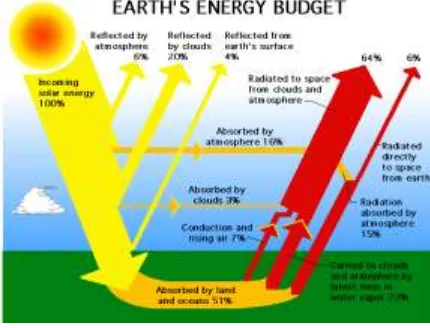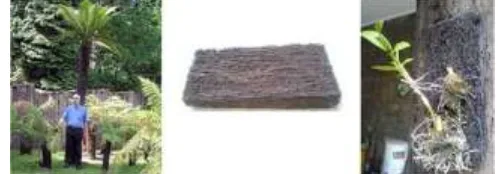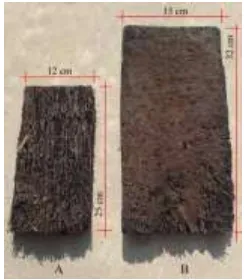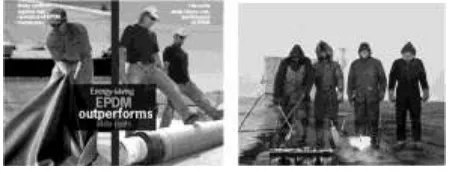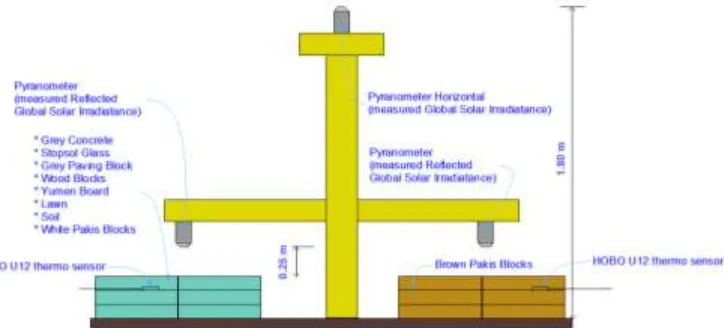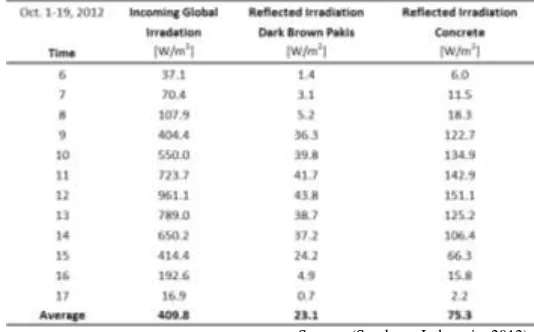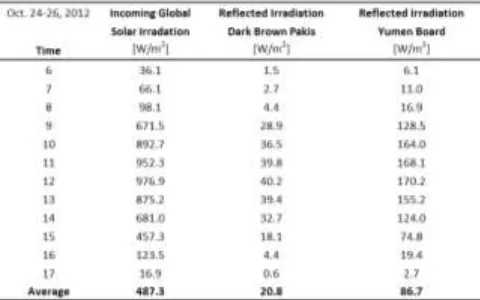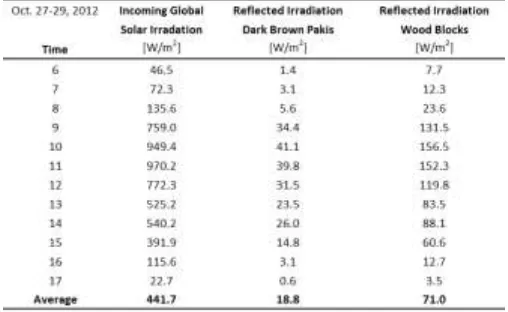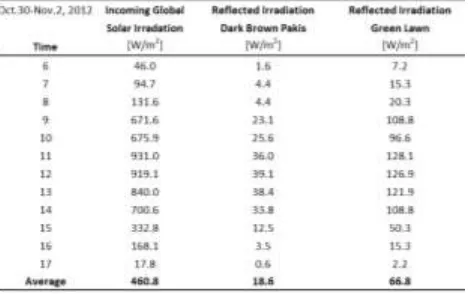CONTRIBUTION OF DARK BROWN PAKIS-STEM TO
MITIGATE THERMAL SOLAR IRRADIATION OF A
HEATED ENVIRONMENT
Danny Santoso Mintorogo
Department of Architecture, Faculty of Engineering and Planning, Petra Christian University, Indonesia Email: dannysm@peter.petra.ac.id
ABSTRACT
In the era of global warming issues areal most happening every time and day in many countries, one of the possible to apply brown and white-pakis blocks as high-albedo heat insulation in the urban cities is on the flat concrete rooftops. The brown-pakis blocks will absorb much incoming global solar irradiation and emit less longwave solar heat to space; in contrast, the white-pakis blocks could not only handle well the incoming solar irradiation but it also to lessen the outgoing longwave solar irradiance by simply emiting much irradiation to atmosphere and performing as insulator to the flat concrete rooftop. This research is concentrated on the ability of brown Pakis-stem blocks to reflect less outgoing solar irradiation to space, but to absorb and to emit as much possible of longwave solar heat irradiation. The results of brown Pakis-stem blocks are proved to reflect an average 18.2 W.m-2 compare to white Pakis blocks 71.7 W.m-2 of outgoing global solar irradiance to atmosphere. The average surface bottom temperature of one-piece brown-Pakis block is 34.8oC compare to 33.9oC white-Pakis block. The contribution of brown-Pakis blocks lessen the over heated environment, and act as solar irradiation controller and temporary container.
Keywords: Brown Pakis-stem blocks, thermal solar radiation, heated environment
1.
Introduction
irradiance that causes warmer surface, and longwave heat thermal energy will be emitted less to the atmosphere. Table 1 gives an image of albedo percentages of many surfaces that can be used on buildings and the urban built environment to reduce thermal heat irradiance. Besides albedo one of the factors causing great demand of energy in air conditioning buidlings is the impacted high intensity of solar heat sun irradiation during the daytime that pierces through opaque-walls, curtain-glass walls, windows, and roofs in any tropical climate region around the world. According to Nazar et al. (2003) roofs on single buildings donate almost 36,7% of solar heat irradiation into the buildings. Moreover there is up to 50% of solar thermal radiation that comes from flat rooftop [5]. The flat rooftops and curtain-glass facades will receive and reflex solar heat thermal radiant to urban environment. Table 2 shows the flat concrete rooftop received hourly average of horizontal global solar irradiation of 383 W.m-2 on dry season and 340 W.m-2 on wet season in year 2007. The highest impacted global horizontal solar irradiance is about 978 W.m-2 at 11 am on October 31, 2008. And high horizontal global solar irradiation concentration happened in the year 2008 [2].
Table 1. Surface Albedo as a Decimal Albedo and as a Percentage (Source: http://education.gsfc.nasa.gov)
Table 2. Hourly Average Dry and Wet Seasons Horizontal Global Solar Irradiance in Surabaya-
Indonesia per year 2007,2008,2009
(Source: Surabaya-Indonesia, 2008)
Meanwhile Tabel 3 demonstrates an average of hourly vertical global solar irradiation based on Surabaya’s local climate around 198 W/m2
Table 3. Hourly Average Vertical Global Solar Iradiatiance in Surabaya per year 2007
(Source: Surabaya-Indonesia, 2008)
All the sun’s ray along with high intensity of solar heat irradiation will produce thermal heat on a surfaces that are absorbed or reflected by building rooftops, facades, pedestrians, street materials, and trees. Absorbed global solar irradiation coming to the earth will increase the outer surface temperatures of all surface materials by action of reflected and absorbed; on the building rooftops from around 30 to 40oC [1]. Figure 1 shows the earth’s radiation budget where the earth is always trying to balance the received short wavelengths of sun solar radiation by absorbing, reflecting back and emitting part of irradiations to the space. Meanwhile the ambient air temperature in atmosphere increases due to the emitted longwave energy from the earth’s or other materials. The lighter and harder a surface material is, the higher the emitted longwave energy bounced back to the atmosphere and the earth. The urban heat island effect is due to soaring reflected air temperatures that is coming from many ligher and harder urban features and building surfaces. The surrounding built environment is lacking in absobing or has low level of emitted longwave energy features and surface materials like parks with big trees and green lawn, dark soil, wooden-pedestrian way and greenary rooftops as well as low-emitting longwave energy of pakis-stem blocks as rooftop cover material. Based on Surabaya’s weather station report that yearly average of outdoor maximum temperature and minimum temperature in October 2008 are 33.9oC and 22.1oC respectively [8].
(Source: Science-edu, 2012)
Figure 2.Town-Houses and Shop-Houses on Business-Street Zones
Surabaya is the second largest city in Indonesia, with the latitude of 7o 17-21’ South. From year 1995 till now, a lot of business placeses are needed to build. Middle-class businessmen or presetting business firms can’t afford to rent office spaces on high-rise buildings. Therefore, single-houses, town-houses, shop-houses, and even dwellings along the main streets become favorite placeces to do business. Figure 2 exhibits a lot of new towns, shops, and office-houses built to two or three stories with majority of flat bare concrete rooftops of around 5,900 m2 at Putro Agung’s business zone (A), Klampis Jaya central business district 31,00 m2 (B), Manyar Kertoarjo’s business-zone 12,400 m2 (C), as well as Galaxy’s Shops, offices and houses 24,000 m2 (D). All these flat bare concrete rooftops are not insulated on top or beneath the concrete roof decks. Less greenary rooftops and high trees are planted along the business zone street. Concrete-block pavings are dominantly covered to walk-ways, and street-ways are built up of dark-asphalt. Could one imagine how much watt per square meters of out-going solar heat irradiance from these materials will bounce back to the built-up areas, and how much air temperatures of thermal conduction, convection and irradiation will add up to the urban-business heat island?
By applying rows of pieces of Pakis blocks on top of the flat bare concrete rooftops mainly as external enveronmental friendly roof thermal insulation, the reflected solar heat irradiation to built- environment will be controlled. Pakis blocks will absorb much of these solar heat irradiation to prevent too much heat reflected to the environment. What are the pakis-stem blocks? Generally knowledge of pakis-stem blocks are commonly sold by orchid flower shoppers, and flower users always attach the orchid on top of Pakis blocks. These Pakis blocks come from Pakis trees which could be found in the tropical forest; the Pakis tree’s stems are then sliced into pieces of Pakis blocks.
Pakis Blocks are sold in different sizes in the market; as shown in A & B (fig. 4). Pakis Blocks small size (4A) in 1 m2 will have 33.3 blocks and weigh 5.2 kgs for dry pakis blocks; in wet condition, small size pakis blocks in 1 square meter have weight of 7.3 kgs. Meanwhile for big size pakis (fig. 4B), 1 square meter will contain 20.83 blocks, and the weight 5.2 kgs (dry condition), environment from flat concrete rooftops and many elements around the built environment. The applicantions are: green roofs or rooftop gardens, cool roofs (built-up roofing), and double roofs [3].
2.1
Green Roofs or Roof Gardens
Green roofs or Rooftop gardens have two kinds of greenery roof systems that are extensive and intensive green roofs. Extensive green roof characteristic is not to design for public excess, it is merely for aesthetic and ecological environment proposes, low-cost due to lightweight construction, low maintenance, thin layer of soil, and smaller vegetation (merely bushes). Contradictory to extensive green roofs, intensive green roofs are designed for public excess-way or roof garden-playground on rooftop parking buildings, high plants (scrubs or trees), thick substrate, heavyweight construction, and high maintenance [9,3].
Tested on intensive roof garden landscaping on low-rise commercial building, the maximum hard surface temperature (without soil and plants) at 2 pm is 57oC; the maximum bare soil surface temperature is 42oC. With the presence of vegetation that is totally dependent on the Leave Area Index (LAI), higher temperature will happen on meagre foliages and lower temperature on intense ones. The maximum temperature on all kinds of vegetation under foliages is about 36oC; and the maximum soil temperature with plants is 26.5oC [9].
has the faster cooling effect at night among the other roof materials. Moreover metal roof is lightweight structure and has a low maintenance factor.
2.3
Coolroofs
Cool roof was invented by Dick Bourne in 1980 at Davis, California. This system uses concrete roof as roof pond with impermeable floating insulation panels in water; the water is then pumped over the insulation during the night in order to have longwave sky radiation cooled the water. The cooling water temperature could be around 1-2oK above the average ambient WBT, and the ceilling temperature (exposed concrete) would have about 2oK over the water temperature [4]. An indoor temperature of 25oC would be obtained with the maximum outdoor temperature of 37oC during the daytime; the water pond temperature will fluctuate a round 5oC [4].
2.4
Bittumen Roll Roofing Sheet
Single-ply Rubber Membrane Roofing. (EPDM): Ethylene Propylene Diene Poly Methylene is applied to flat rooftop concrete to give great protection to solar radiation through roof. It is great rubber roofing sheet but it is not an environment friendly insulation material (fig. 5).
(Source: Science-edu, 2012)
Figure 5. Applying Single-ply Rubber Membrane Roofing. (EPDM)
3.
Methodology
The research is an experimental works conducted at Petra Christian University, Surabaya-Indonesia on two-story flat concrete rooftop building. The global solar irradiation data were recorded hourly and were taken at least 2 to 3 days or more respectively and simultaneously on rooftop with digital data logger and pyranometer of HOBO. Series of row and column of 3-layer to 5-layer thick pakis blocks are laid down on bare concrete rooftop acting as a insulator to diminish thermal heat into a room.
3.1
The scheme
The reflected global solar irradiation measurements were taken to compare to brown-pakis blocks with other materials respectively; each measurement with different material to brown-pakis blocks was measured between two to three days period. The major measurement on this research is to know how much the white-pakis blocks reflect outgoing global solar irradiation to the space environment than the brown-pakis blocks.
Figure 6.Ways of Measureing Reflected Global Solar Irradiation and Longwave Heat Energy
3.2
The Measuring Tools
Many kinds of ―HOBO‖ (Onset Inc. products) measuring tools were used to obtain data in many fields of the research; the intensity of global solar irradiation and the degree Celcius of longwave heat irradiation absorbed. HOBO U12 external data logger has a mesurement range of temperature -20o to 70oC, RH 5% to 95% with accuracy temperature of +- 0.35oC from 0 to 50oC, and RH +- 2.5% from 10 to 90%. The water/soil temperature sensors have a technical measurement range of temperature -40to 50oC in water, and -40 to 100oC in air with accuracy of +- 0.25o at 20oC. The HOBO Micro Station data logger has a four sensors for multi-channel measurement at the same time. It can be connected to a silicon Pyranometer smart sensor that has a technical measurement range of global and direct irradiation of 0 to 1,280 W/m2, and the spectral range of 300 to 1100 nm with angular accuracy of cosine corrected 0 to 80 degrees from vertical. The sensor resolution is 1.25 W/m2.
4.
Results and Discussions
Table 4. Hourly Average Horizontal Global Solar Incoming and Reflected Irradiation for Dark Brown Pakis and Rooftop Concrete in Surabaya October 1-19, 2012
Source: (Surabaya-Indonesia, 2012)
The average reflected solar irradiation of Stopsol classic dark blue glass (it is often used as curtain-glass or large windows on the modern buildings) is 59.3 W.m-2; it is 38.9 W.m-2 larger reflected solar irradiation then brown pakis blocks did, and the albedo is 66.6% higher than brown pakis blocks (Table 5).
An average of 61 W.m-2 reflected global solar irradiation of grey paving blocks were recorded as outgoing solar irradiance to space like other reflected solar irradiations from many surfaces within the boundary of the atmosphere in the earth (fig.1). With contrast to average reflected solar irradiation of brown pakis blocks had merely 20.2 W.m-2 at particular days, the brown pakis blocks can mitigate more 201% of reflected solar irradiation than the grey concrete-paving blocks to the living environment at very hot-daytime; shaded outdoor temperature is 34.9oC at 13.00 pm (Table 6 & Table 12).
Yumen boards are man made wooden-baggy-panels resembling pakis-stem blocks (natural blocks). The main function of the Yumen boards are for wall panels, ceiling panels, and as acoustic panels. The average reflecting solar irradiation is quite high; reflected solar irradiation of 86.7 W.m-2 will be mirrored to space, and it is 76% higher of reflected solar irradiation than brown Pakis blocks (Table 7)
Table 5. Hourly Average Horizontal Global Solar Incoming and Reflected Irradiation for Dark Brown Pakis and STOPSOL Classic Dark Blue Glass in Surabaya October 20-21, 2012
Source: (Surabaya-Indonesia, 2012)
Table 6. Hourly Average Horizontal Global Solar Incoming and Reflected Irradiation for Dark Brown Pakis and Grey Paving Block in Surabaya October 22-23, 2012
Source: (Surabaya-Indonesia, 2012)
Table 7. Hourly Average Horizontal Global Solar Incoming and Reflected Irradiation for Dark Brown Pakis and Yumen Board in Surabaya October 24-26, 2012
Table 8. Hourly Average Horizontal Global Solar Incoming and Reflected Irradiation for Dark Brown Pakis and Wood Blocks in Surabaya October 27-29, 2012
Source: (Surabaya-Indonesia, 2012)
Green rooftops at city buildings will lessen the urban heat island only if all the buildings are built with grennary rooftops. Regrettably, the average reflected global solar irradiation of green lawn is still 72.2% higher than brown pakis blocks. This phenomena is due to a higher reflected solar irradiance of greenary lawn of 66.8 W.m-2 than the brown pakis blocks of 18.6 W.m-2 (Table 9).
Preferably if a built environment city has more parks and soft darker soil than grey concrete paving blocks as pedestrian-ways and verhicle-ways, there will be more incoming global solar irradiation absorbed to the earth than outgoing global solar irradiation to the space in the built environment. By looking at table 9, where the average of global solar irradiation of dark-soil is closed to dark brown pakis blocks of 18.2 W.m-2; only 25.4% of reflected global solar irradiation of dark soil is higher than brown pakis blocks (it is the smallest percentages among other reflected global solar irradiations tested than pakis blocks). The 24.4 W.m-2 of outgoing global solar irradiance of dark soil will be an added values to the built environment (Table 10).
Table 9. Hourly Average Horizontal Global Solar Incoming and Reflected Irradiation for Dark Brown Pakis and Green Lawn in Surabaya October 27-November 2, 2012
Source: (Surabaya-Indonesia, 2012)
Table 10. Hourly Average Horizontal Global Solar Incoming and Reflected Irradiation for Dark Brown Pakis and Dark Soil in Surabaya November 2-4, 2012
Source: (Surabaya-Indonesia, 2012)
Table 11. Hourly Average Horizontal Global Solar Incoming and Reflected Irradiation for Dark Brown Pakis and White Pakis in Surabaya November 5-9, 2012
Table 12. Hourly Average Bottom Surface Temperatures of 3-cm Thick of Dark Brown Pakis and White Pakis in Surabaya November 13-16, 2012
Source: (Surabaya-Indonesia, 2012)
5.
Conclusion
After analyzing the average measurement results of global and direct reflected solar irradiation on many surface materials, mainly the brown Pakis-stem blocks, some pieces of evidence on reflected global solar irradiance can be drown. At first, the incoming global and direct solar irradiation will be absorbed much by darker surfaces. Lighter surface materials will reflect as much as possibly solar irradiance to space. This phenomenon—lighter surface material, will contribute to increase the city temperature during the daytime; harder, lighter, and reflected city and building surface materials can escalate atmospheric temperature. Secondly, the darker surface like brown Pakis-stem blocks absorbed much of incoming solar irradiation and reflected less; as a matter of fact brown Pakis blocks will emit more longwave heat energy to space according to its thermal handling capacities (thermal lags). The only action to be done is to provide better external thermal insulation on flat rooftops in order to prevent over heating through absorbed incoming longwave heat solar irradiation. By doing all these, an over heated urban environment by many hard surfaces will be alleviated simply applying brown Pakis-stem blocks to cover flat-rooftop buildings as thermal barrier and storage.
References
[1] Adamson, B., Olle, A. Design for Climatization: Houses in Warm-Humid Areas. Building Issues,1993; 5(1)
[2] Mintorogo, Danny S. Monthly Average Horizontal and Vertical Global Solar Irradiance 2008 in Surabaya, Research Report, Petra Christian University; 2008
[4] Givoni, Baruch. Passive and Low Energy Cooling of Buildings.New York: Van Nostrand Reinhold; 1994
[5] Nahar NM et al. Sudies on Solar Passive Cooling Techniques for Arid Areas. Energy Conversion &Management, 1999; 38, p.89-95
[7] Nahar NM, et al. Performance of Different Passive Techniques for Cooling of Buildings in Aris Regions. Building and Environment, 2003; 38, p.109-16
[8] Tjahjono, Endro. Weather in Juanda Surabaya 2008
[9] Wong, N.H., Chen, Y.A. Comparison of Two Rooftop Systems in the Tropical Climate. In: Proceeding of the INTA 2ndHarmony in Culture and Nature Conference, 2006; Indonesia, B14, p.1-8
Website:
